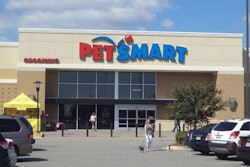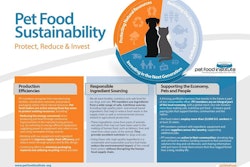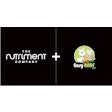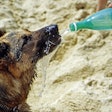
To discuss grain-free pet food, I will focus on extruded kibble since this category makes up most of the pet food products in the marketplace today. In one of my future blog posts, I will review other pet food product forms (raw, homemade, freeze-dried, baked kibble, etc.). Originally, I was only going to explore grain-free versus grains; however, it would be hard to discuss this comparison without including carbohydrates. To begin our discussion, I will first focus on carbohydrates and digestibility.
What are carbohydrates, and are they digestible?
Carbohydrates consist of simple sugars (e.g., glucose) and disaccharides (e.g., sucrose or table sugar), oligosaccharides or polysaccharides (e.g., starches). Before I move to the next section, I think it is important to point out that grain free does not equal starch or carbohydrate free.
As I reviewed in my first blog post (Your dog is not a wolf), starch digestibility is similar in dogs regardless of source (grain based or grain free). Numerous studies have published similar digestibilities (>98 percent) for dog food made with grains (corn, barley, rice, sorghum – milo – and wheat) and grain-free (potato, peas, lentils, cassava – tapioca flour) dog food (Murray et al., 1999; Carciofi et al., 2008; Bazolli et al., 2015).
In cats, de-Oliveira et al. (2008) investigated the starch digestibility for both grain (corn, rice and sorghum/milo) and grain-free (lentil and pea) carbohydrate sources. All starch digestibilities were >93 percent, indicating that cats can digest carbohydrates efficiently if they are extruded. Additionally, all formulas in their study were formulated for 35 percent starch.
The scientific data does not support the notion that grain free is better than grains. Now you are probably asking, that doesn’t make sense, how is that possible? You have likely read conflicting information on several websites or were told differently by a sales representative.
Also, you will notice that I didn’t report any ancient grain, chickpea or sweet potato peer-reviewed scientific studies. To date, none exist.
Extrusion makes all starch sources equal
This shouldn’t come as much of a surprise to most people in the industry. Most dry kibble processing starts with a grinding phase for product uniformity, followed by a cooking phase that gelatinizes or cooks the starch for greater digestion and bioavailability (i.e., ↑ cook = ↑ gelatinization of starch = ↑ digestibility and availability). However, digestion and bioavailability can be decreased if the processing time is too long or temperature is too high (Buff et al., 2014).
The high digestibility of these starches mentioned above will yield more available nutrients for available energy usage and storage (Crane et al., 2010). Additionally, it should be noted that nearly 100 percent of the glucose available is completely absorbed in both dogs and cats (NRC, 2006).
Dogs and cats need glucose to survive
Similar to humans, there is a mandatory requirement for glucose in organs such as the brain in the dog. As a result, when dietary glucose (i.e., starch) is not supplied in the diet, the dog’s body will utilize amino acids and glycerol to synthesize glucose via gluconeogenesis. Additionally, cats are always in a state of gluconeogenesis, indicating that glucose is important for normal metabolism as well and is why cats do need higher protein diets. Although, it is important to point out that cats do not utilize carbohydrates as rapidly as dogs (NRC, 2006). If it is not supplied in the food, it will be made internally (assuming they have the proper building blocks). Thus, carbohydrates are good for both dogs and cats and are necessary for survival.
Myth busted: carbohydrates make my dog or cat fat
As a nutritionist, one of the first things I learned in school were the following relationships to energy consumption and requirements:
- Weight maintenance (energy balance): calories consumed = calories burned
- Weight loss (energy imbalance): calories consumed < calories burned
- Weight gain (energy imbalance): calories consumed > calories burned
Another critical learning was the modified Atwater equation for calculating metabolizable energy (ME) of a diet, an indicator of available energy. This equation is currently used in the pet food industry to predict ME for feeding guides and product labels when animal testing has not taken place (AAFCO, 2017):
ME (kcal/kg) = 10[(3.5 × Protein) + (8.5 × Fat) + (3.5 × Carbohydrate)]
As you can see with the above co-factors, both protein and carbohydrate are weighted equally; however, fat has a co-factor of 8.5. What does this mean in layman terms? The dog or cat’s body receives 2.25 times the calories from fat than from both carbohydrates or protein. We all know that weight gain results when more calories are consumed than burned. Assuming we keep ME constant, I could switch protein and carbohydrates 1:1 with no impact to ME. The only way I can lower ME in the foods is by reducing fat. Consequently, most weight management foods are reduced calorie and/or fat. A secondary option would be to feed less product.
In summary, it’s over-feeding calories, not carbohydrates, that causes weight gain in dogs and cats. It may sound crazy and off-base; however, I remember when I started my career, the guaranteed analysis for fat in dog foods were 10-12 percent. Today, fat guarantees can be 15 percent or higher.
Did anyone tell the consumer to change their feeding habits?
With the higher levels of fat and calorically dense foods we see today, I strongly believe that we should provide better feeding guides on websites (with more detail than packaging labels). This can then help pet parents and vets alike dial in on an individual pet’s energy needs given each unique situation (versus broad categories).
I have a Boston Terrier that is a couch potato. Since her activity level is minimal (except when I come home), I adjust my feeding based on her body condition score. If I blindly followed the feeding guidelines on the bag, she would be a Boston Weeble Wobble.
So how did industry get here?
If science doesn’t support the notion that grain free is better than grains, then how did the industry as a whole get there? As previously discussed by Phillips-Donaldson (2017), the 2007 melamine-related pet food recalls made many consumers aware of how pet food is made, where the products were made and the ingredients utilized (and sourced) in the foods they purchased. As a result, the consumer quickly realized that premium and grocery pet foods contained many of the same ingredients.
This provided an opening for companies to begin distinguishing and marketing themselves from other companies because of their premium products with the lack of certain ingredients or ingredients sourced from China. Many of the first claims to appear in the market place were tied to carbohydrates and focused on no corn or wheat. These initial claims made sense because wheat gluten was the main ingredient behind the 2007 recalls. Shortly thereafter, the mainstream brands caught up to the trend-setters, and then you had grain free and gluten free flooding the market.
How are companies going to differentiate themselves now?
Another good question. At Petfood Forum 2017, I discussed how grain free is no longer a distinguishing feature between premium brands in both the pet specialty and grocery channels. During Maria Lange’s (GfK) presentation, she also highlighted the fast-growing new tier of brands (labeled as “value” natural) that are grain free and gluten free and cost the consumer on average 20 percent less.
So how will companies differentiate? I had the same question as I walked the floor at both Global Pet Expo and SuperZoo in 2017. I observed pet food packaging touting no white potato, potato free (including sweet potato), includes ancient grains (millet, quinoa and amaranth) or includes legumes (chickpeas, lentils and beans). Kind of humorous if you think about it, since many of the brands still have products in the marketplace with the ingredients that are now consider taboo. All I know is that I am not sure where we as an industry will go from there (maybe bad proteins or fats?).
Next topic: Do grains impact digestibility and skin/coat quality?
Next time we will discuss this topic: “Do grains impact digestibility and skin/coat quality?” Bob Bamberg (@bobbamberg) wrote in asking, “I would like to know if grains such as corn, soy, sorghum, wheat, etc. in dog and cat food do actually affect digestibility and skin/coat quality as many pet food reps preach.” I will address his inquiry along with questions he can ask and what information manufacturers should supply when making these types of statements.
If there are topics you would like to have discussed, feel free to comment below or reach out via LinkedIn: www.linkedin.com/in/ryanyamka.
References
AAFCO. 2017. Association of American Feed Control Officials: Official Publication.
Bazolli et al. 2015. Effect of the particle size of maize, rice and sorghum in extruded diets for dogs on starch gelatinization, digestibility and the fecal concentration of fermentation products. J. Anim. Sci. 93:2956–2966.
Buff et al. 2014. Natural pet food: A review of natural diets and their impact on canine and feline physiology. J. Anim. Sci. 92:3781-3791
Carciofi et al. 2008. Effects of six carbohydrate sources on dog diet digestibility and post-prandial glucose and insulin response. J. Anim. Phys. and Anim. Nutr. 92:326–336.
Crane et al., 2010. Commercial Pet Foods: In Small Animal Clinical Nutrition, 5th Edition. Topeka, Kansas: Mark Morris Institute, p. 157-190.
de-Oliveira et al. 2008. Effects of six carbohydrate sources on diet digestibility and postprandial glucose and insulin responses in cats. J. Anim. Sci. 86:2237–2246
Lowrie et al. 2016. A presumptive case of gluten sensitivity in a border terrier: a multisystem disorder? Vet Rec. 179:573
Murray et al. 1999. Evaluation of selected high-starch flours as ingredients in canine diets. J. Anim. Sci. 77:2180-2186
NRC, 2006. Carbohydrates and Fiber: In Nutrient Requirements of Dogs and Cats. Natl. Acad. Press, Washington, DC. p. 49–80.
Phillips-Donaldson, 2017. Why consumers think so many pet food ingredients are bad.
Roudebush et al., 2010. Adverse Reactions to Food: In Small Animal Clinical Nutrition, 5th Edition. Topeka, Kansas: Mark Morris Institute, p. 609-636.
Roudebush and Schoenherr, 2010. Skin and Hair Disorders: In Small Animal Clinical Nutrition, 5th Edition. Topeka, Kansas: Mark Morris Institute, p. 637-665.
















